|
Introduction
Outcrops of fossiliferous
Permian Fort Apache Limestone are very rare off the Reservation,
most localities where the rock outcrops such as in Sedona or
Pine have no fossils to speak of. Because we wish to promote
the collection, curation and study of the Fort Apache Limestone
microfossils, we are going to give you a map to the locality
below. If your looking for big flashy fossils laying around the
ground, this is definitely NOT your location! To collect here,
we parked next to the site along the road way and picked up promising
pieces of limestone that had fossils externally visible. But
there is no guarantee that when you dissolve this rock in muriatic
acid, that you will have abundant silicified fossils. Many of
the fossils are also calcified and will dissolve in the acid.
While the fossils recovered
at this site were not as well preserved as on the High line Trail
site, a good assortment of micro and small fossils were recovered
from the acid fines. We will highlight here some of the best
of what we found - Over a dozen fossil types and many more gastropod
species.
The Locality
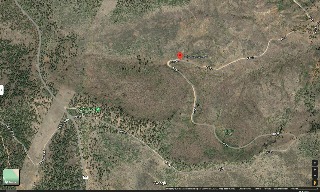 (Click to Enlarge)
(Click to Enlarge)
|
Fr33
is a decent dirt road, but with a bit of washboard. Probably
dont want to take the family car down this one, you might rattle
it to death. Any pickup or off road vehicle will make it fine.
Marked in red is the location of the outcrop, on the north side
of a straight area in the forest where the outcrop appears as
a light grey limestone coming down the hillside. You can climb
this as well and get better specimens as you head a bit up the
hill. |
Some Photos
of the Site:
(Click to Enlarge)
What was found
About 150 pounds in
rock were put through the acid bath, and the following were found
under the microscope:
1. A large amount of Urchin material
2. A Dozen of poorly persevered Branching / Encrusting Bryozoans
3. Half a dozen Serpulid Worm domiciles (Chonetes)
4. About a dozen of nice Scaphopods, some approaching pencil sized.
5. A single Ostracod!
6. A hundred or so of both superbly - and poorly preserved Gastropods
7. Sponges, about a table spoon worth
8. half a dozen Trilobite bits and one very nice pygidium
9. Lots of small bivalves - very generic low diversity
10. A few Straparollus gastropod parts with two complete larger specimens
11. And one Brachiopod (other than productids)
12. half a dozen productids
13. Bellerophontid Gastropods
14. Quartz crystals
And here is what was NOT found that had been at other sites along the trail:
1. No productid spines
2. No solitary rugose corals
3. Not a single crinoid ossicle
4. No metal particles
5. No Nautiloids
6. NO winged clams
7. NO sponge roots
For a site with moderately
poor preservation of fossils, there were a few surprises!
The Fossil
Photos.
Identifications are
based on the very limited literature on the Fort Apache limestone,
and the more common Kaibab formation, both are Permian, however
the Kaibab is later in time. GSA Memoir 89 by Steven Winters
in 1963 is the definitive source.
A few words on how these
photos were taken. Using an Amscope stereo microscope, one or
two dozen shots of each subject were taken with the focus shifted
a bit between shots. The focus stacking software Picolay was
used to combine the images to obtain one frame of fully sharp
focus. Thousands of frames are treated in this manner and the
final images of the Fort Apache micro fossils you see here are
the results of a huge amount of work! Enjoy.

Trilobites:
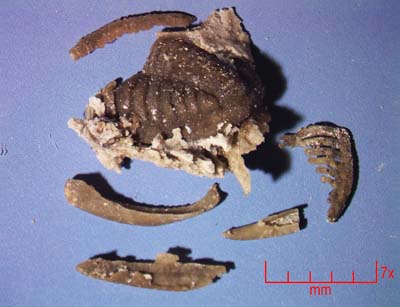
|
Phillipsia
sp. Surprisingly, a
few front rims, a solitary genial spine, and a bit of thoraxic
ribs was found, and one mostly complete fully silicified pygidium. |
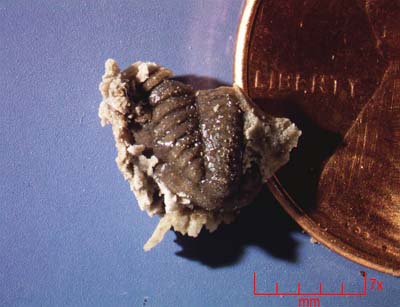
|
Phillipsia
sp. A lot of material
was glued to it with silica, but you can clearly see the full
thickness of this cast. |
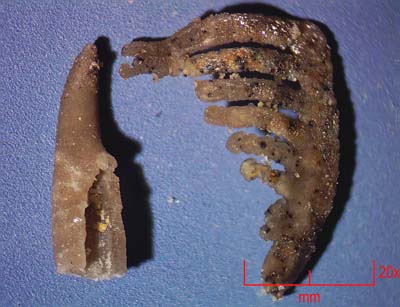
|
Phillipsia
sp. One genial spine
on the left, along side a "rack" of trilobite ribs.
Hard to believe such a delicate thing as this survived the lag
deposit. |
Brachiopods:
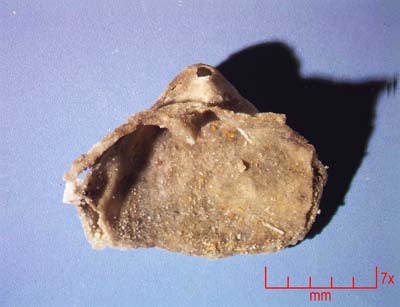 |
Genus and
species indet. ONE
brach was found, this is its underside on its pedicle valve. |
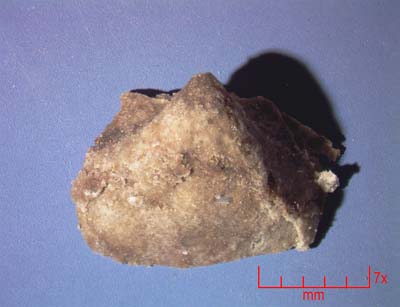 |
Genus
and species indet. Top
side of the same brach. |
Bryozoans:
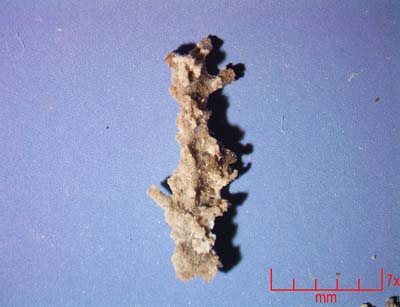 |
This
appears to be an urchin spine coated with an encrusting Bryozoan. |
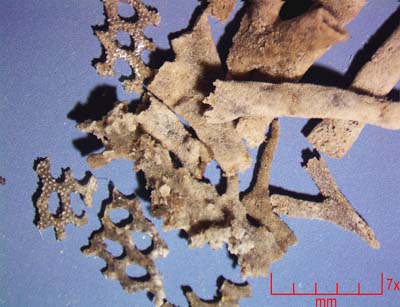 |
There
were two types of bryozoans found, the Fenestrate type and the
Y branching tubular type. |
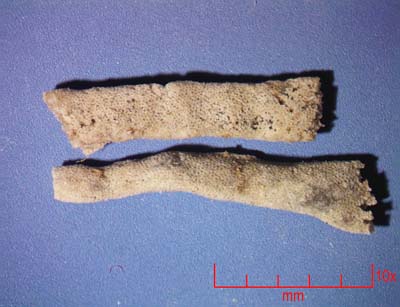 |
The
branching type imaged closer to show pores. Again, preservation
here is not the best, but you can see the openings for the zooids. |
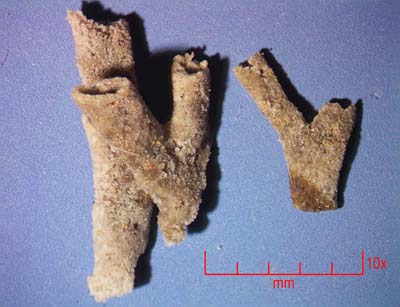 |
The
Y branches commonly found, same species. |
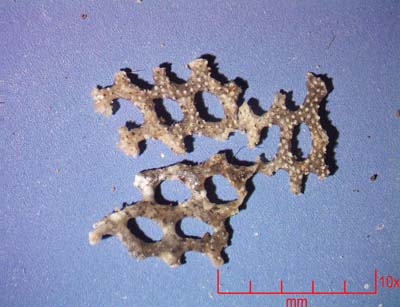 |
The Fenestellid
bryozoans made their appearance with these few fragments. |
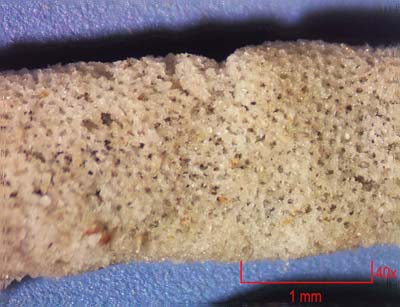 |
40x Close
up of the branching tubular type. |
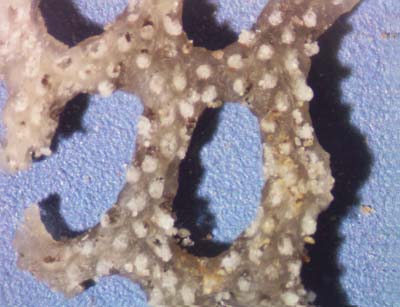 |
40x
Close up of the Fenestellid type. Each white bump contained a
single zooid. |
Chonetids (Serpulid
Worms):
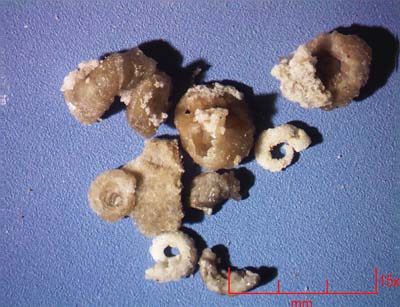 |
Essentially,
these are serpulid worms domiciles. (like Spirorbis). Winters
never found or photographed these! These tubes are flat on one
side, because they were formed on sea weeds and when the weeds
died, the tube falls off and has a flat on it. |
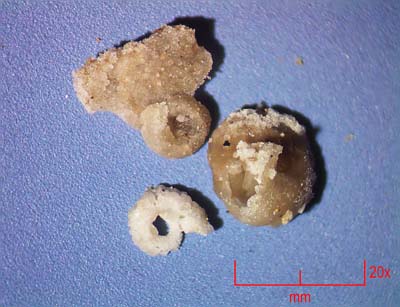 |
The
serpulid worms, with one still attached to a bit of shell. |
Bivalves:
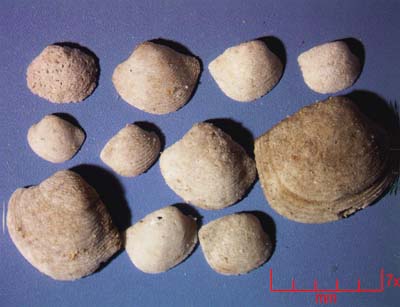 |
Astartella
subquadrata. This is
the dominant species in the Fort Apache Limestone everywhere
we have looked. |
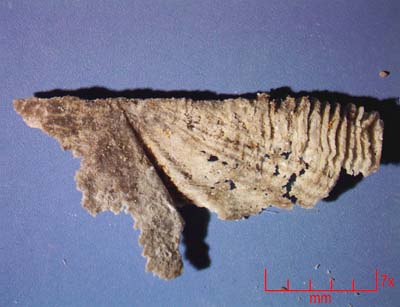 |
Aviculopecten
sp. A small fragment
of what was a much larger shell. This is the hinge area of the
right valve. Winters found exactly the same piece! |
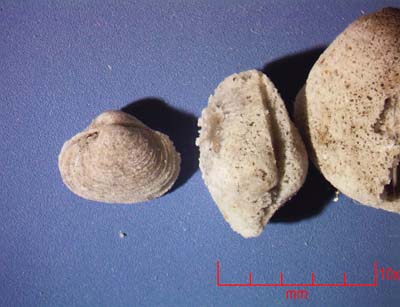 |
Edmondia
sp. The common shells
were also found still together, they died in the sediment without
separating. |
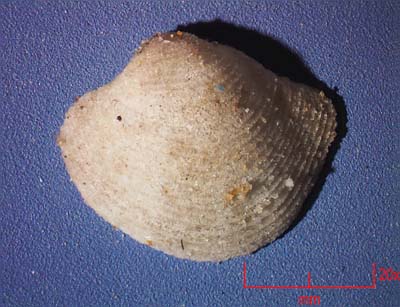 |
Astartella
subquadrata. One of
the best specimens. |
Quartz Crystals:
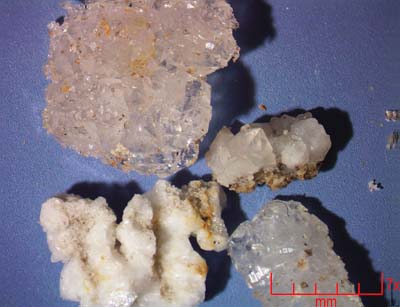 |
Silicon
dioxide sp. Some nice
optically clear types and some milky types as well. |
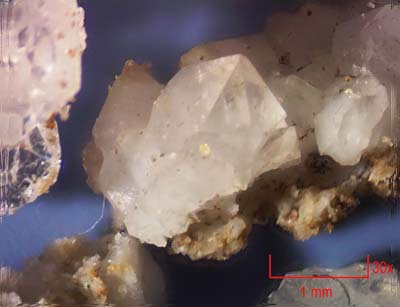 |
Close up
of one of the crystals, that was very well formed. But is only
1mm in size. |
Gastropods:
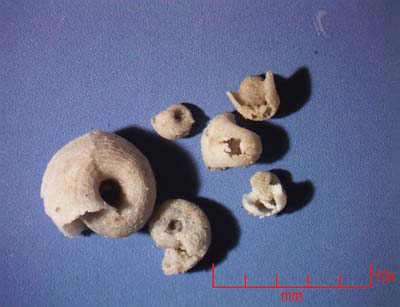 |
Knightite
modestus, A beautiful
spiral wound genus, somewhat resembling Bellerophontids. |
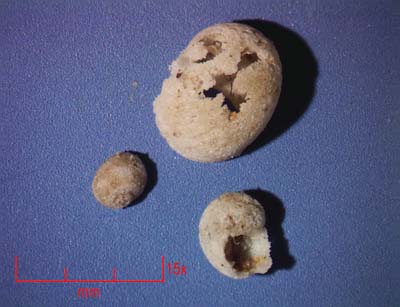 |
Naticopsis
apachensis, Anothere
stunning shape for a small shell, reminds me of shells of today
we found on the beaches of Florida. |
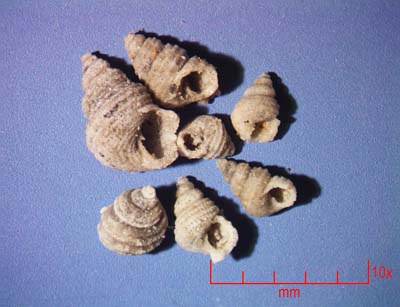 |
Apachella
franciscana. The thick
walled nature of these gastropods made for excellent preservation!
You can look right up inside these like the day they came to
rest on the sea floor. |
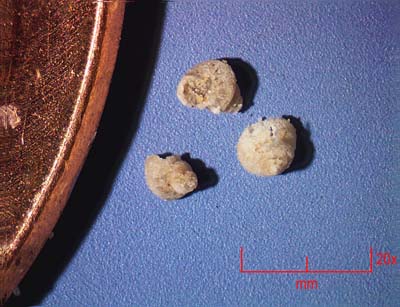 |
Genus
and species indet. The
smallest species in the Fort Apache. |
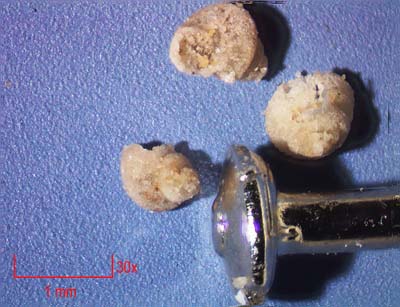 |
Genus
and species indet. Same
species as above, but next to a head of a pin. |
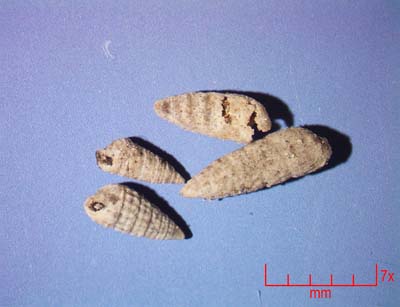 |
Genus and
species indet. Beehive
shaped, very distinctive. |
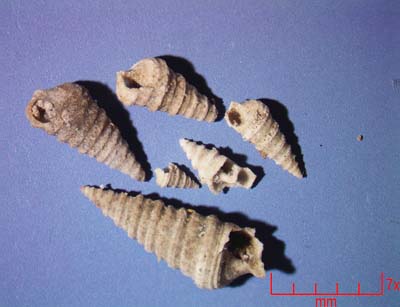 |
Paleostylus
sp. Another thick walled
and very well preserved genus. |
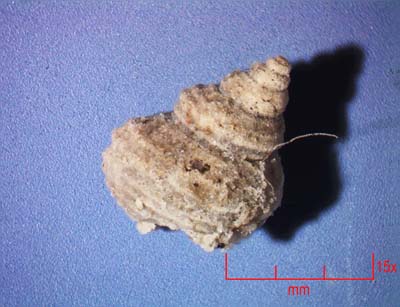 |
Apachella
translirata. The thinner
wall of the shell meant few of this genus was found intact. |
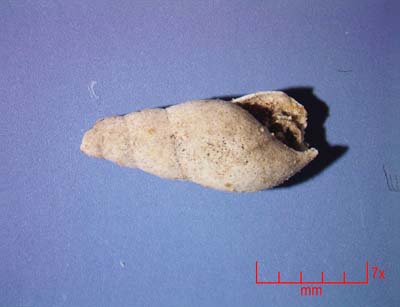 |
Meekospria
knighti. A very "snail
like" look, we found about three of these very distinctive
specimens. |
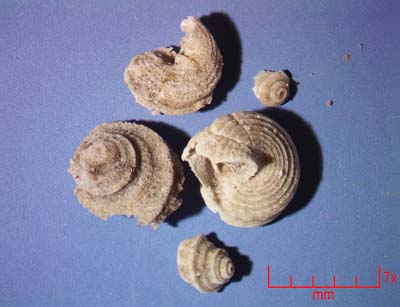 |
Genus
and sp. indet. Thin
walled and break apart very easily. These remind me of the cinnomon
buns at Safeway... |
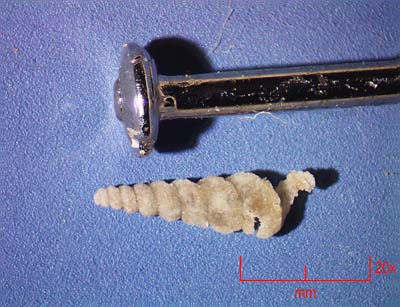 |
Genus
and sp. indet. One
solitary turriculate gastropod was found, and is next to a pin
head here. |
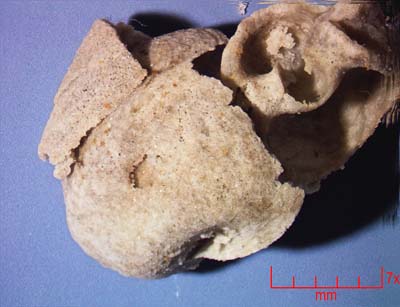 |
Bellerophon
sp. On the left side
is the top of the Bellerophon. The right is another shell attached
to it. |
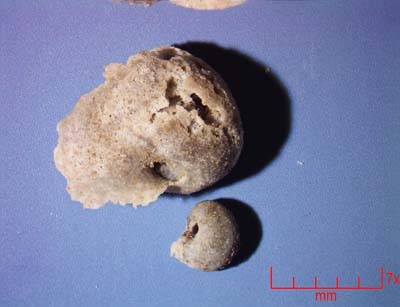 |
Smaller
Bellerophon sp. specimens. |
Ostracods:
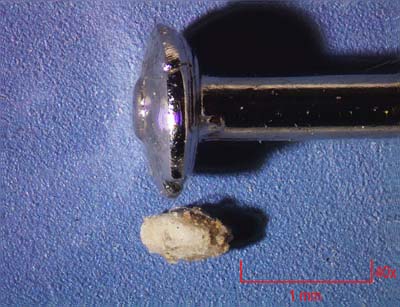 |
Genus
and species indet. Only
ONE Ostracod was found, they were extremely rare at this site.
Yes that is the head of a pin next to it! |
Scaphapods:
 |
Plagioglypta
canna. A nice assortment
of scaphopods, the younger teleoconchs are at the top. |
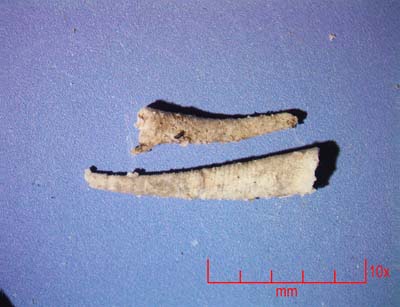 |
Plagioglypta
canna Sizes ranged
from only a few mm to over an inch. Both smooth and ribbed types
found. These are Teleoconchs, which are juviniles. |
Sponges:
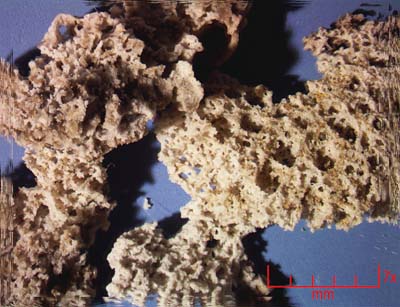 |
The Hexactanellid sponges we found here were quite foamy
looking, and were no doubt much of the source for the silica
in the fossils here. |
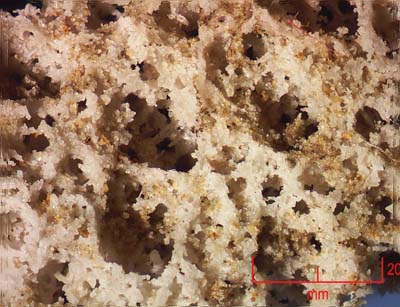 |
Close up of the
foamy nature. |
Straparollus
Gastropods:
 |
Straparollus
kaibabensis Two larger
specimens here, once they get to about an inch in size, they
start to develop the bumps along the shell as seen here. |
 |
Straparollus
kaibabensis One piece
of limestone we found had a cross section of a Straparollus. |
 |
Straparollus
kaibabensis Juvinile
Straparollus. No bumps on shell, but some have early ridges. |
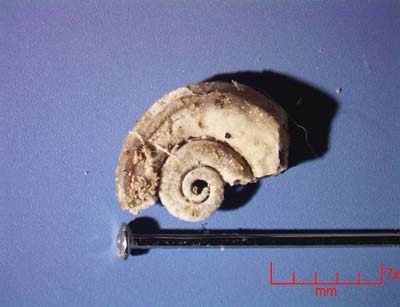 |
Straparollus
kaibabensis Same as
above, this one has a ridge around its edges. This goes away
when they grow larger and become bumps. |
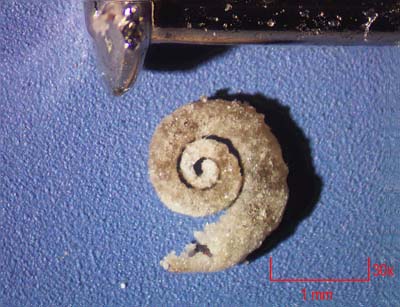 |
Straparollus
kaibabensis Killer
tiny specimen of the juvinile complete with the protoconch! (the
very starting bud in the middle) |
Urchin:
 |
Echinocrinus
trudifer
Hordes of Urchin
spines, plates, and dorsal plates were found. |
 |
Echinocrinus
trudifer. It appears
there are two dominant types of urchins here, one with smooth
spines, and one with spikes. |
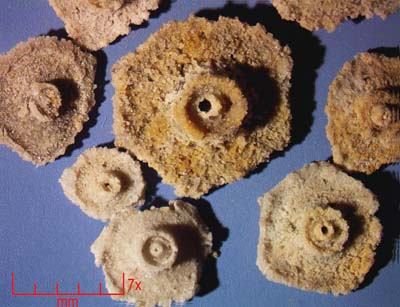 |
Echinocrinus
trudifer Very common
is the individual spine plates. |
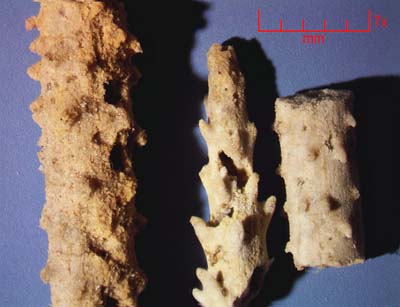 |
Echinocrinus
trudifer Spine detail. |
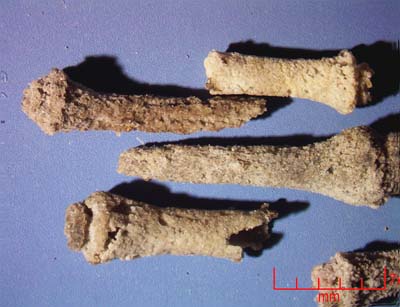 |
Some of
the smooth spines. |
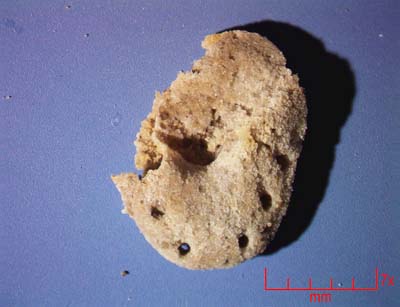 |
Echinocrinus
trudifer This appears
to be one of the plates on the top of an urchin, the inlets for
the water vascular system. |
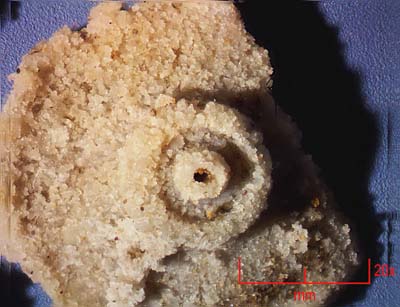 |
Echinocrinus
trudifer Close up of
a spine plate. |
|
